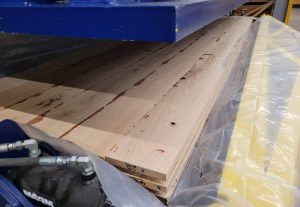
Research by West Virginia University (WVU) professor, Joseph McNeel, and his colleagues suggests that certain lower-grade nature hardwoods, such as yellow poplar, can be an affordable and sustainable alternative to traditional building materials such as softwood, steel, and concrete.
According to WVU Today research writer Laura Roberts, who interviewed Joseph McNeel, the director of the WVU Appalachian Hardwood Center—housed in WVU Davis College of Agriculture, Natural Resources and Design— he has been studying the viability of yellow poplar, an abundant West Virginia species, as an engineered wood building material. Yellow poplar is well-suited for construction due to its straight growth, small limbs, and ease of processing.
While traditional lumber consists of a single piece, a durable and robust product can be created by gluing and pressing multiple pieces together in layers. These layered panels, known as cross-laminated timbers (CLTs), are typically manufactured using softwoods such as spruce, fir, and pine. However, McNeel’s research indicates that certain Appalachian hardwoods, such as yellow poplar, can also be used effectively in structural applications.
In the lab, McNeel and his team have developed panels with three, five, and seven layers using a press that exerts significant pressure. They conducted tests to evaluate the panels’ bending and breaking strength and exposed samples to harsh conditions such as water saturation and dehydration. The results indicated the panels performed well and could be suitable for construction purposes.
The next step is to gain acceptance of yellow poplar as a permissible raw material by the American Panel Association (APA). Once approved, CLT manufacturing companies will be able to incorporate yellow poplar CLTs into commercial construction projects. This development not only benefits the construction industry, but also the forest product companies in the Appalachia region that currently utilize hardwood in low-value items.
In speaking to WVU Today, McNeel said the successful implementation of CLTs relies on the region’s ability to produce them, as the panels are challenging to transport due to their weight. He emphasized the importance of hardwood manufacturing facilities being close to the market to minimize costs.

McNeel and his team are also exploring the use of red oak, another Appalachian hardwood, in the construction of timber mats. These mats are wooden structures used to support heavy-duty equipment on sensitive sites, prone to rapid soil degradation, such as wetland sites. Red oak is highly durable and can withstand harsh climatic conditions, making it ideal for these applications.
McNeel’s research team consists of Curt Hassler, a research professor; Balazs Bencsik, a postdoctoral candidate; Jon Norris, a master’s degree candidate; and Levente Denes, an associate professor in the WVU Wood Science and Technology Program.




